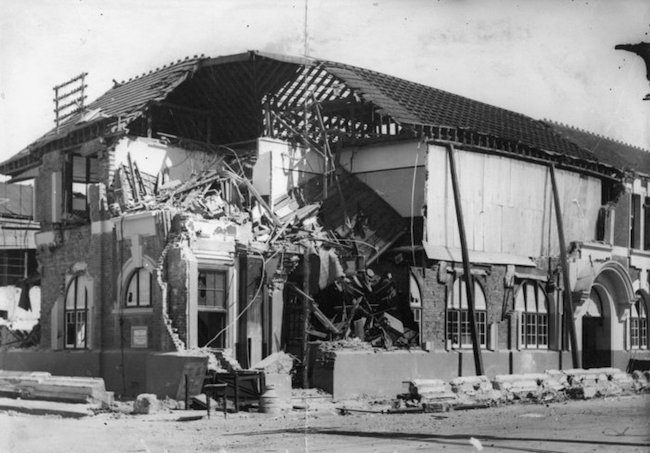 Tuesday 16 April 2019 9:52am
Tuesday 16 April 2019 9:52am
Earthquake damage, Hastings Post Office 1931
New research has found that only three per cent of deaths in the 1931 Hawke's Bay earthquake occurred in people's homes, almost all of which were at that time constructed from wood.
The researchers found it was the collapse of just 15 buildings which caused more than half (58 per cent) of all deaths in the 7.8 magnitude earthquake, which remains New Zealand's deadliest earthquake.
Many of the buildings which collapsed were multi-storey constructions made of unreinforced masonry, which were not only a danger to those inside but also killed people in the street. These deaths in the street accounted for 19 per cent of all earthquake deaths.
The research, by a team of epidemiologists, disaster experts, a genealogist and an engineer (including academics from three New Zealand universities: Otago, Massey and Auckland) found that the 256 deaths and more than 600 serious injuries (in a population of about 50,000) were partly related to the lack of adequate regulations for building construction.
The study's senior author, Professor Nick Wilson from the University of Otago, Wellington, says there were no building regulations at that time which would have been able to reduce earthquake-related risks.

Professor Nick Wilson
“The picture for this 1931 earthquake had some similarities to the Canterbury earthquake of 2011 in that specific buildings caused most of the deaths and unreinforced masonry fell into streets, killing people there.”
Lead researcher Christine Clement also highlighted a unique aspect of the study which involved looking at death certificates for anyone who might possibly have died in the earthquake. “This process resulted in us adding 17 people to previous lists of earthquake victims – but also removing 17 people.
“Most strikingly, we found that a death once considered earthquake-related was actually of a boy who had died the day before and his body was in the hospital morgue, which had collapsed.”
Professor Wilson says the value of wooden buildings has repeatedly been shown in earthquakes in New Zealand, going back as far as the 1848 Marlborough earthquake. However, the lessons of this and further earthquakes were not put into building regulations and New Zealanders continued building in insufficiently reinforced brick, including in multi-storey buildings.
“This was partly understandable when considering the higher fire risk in earlier times, but there seems to be no good excuse for New Zealand authorities to continue to have allowed unreinforced chimneys and masonry on buildings above busy streets in a country with regular earthquakes.”
The multiple benefits of building with wood are increasingly being recognised and multi-storey wood buildings are now being built around the world. The tallest is an 18-storey wooden dormitory at the University of British Columbia in Canada.
The value of wood for carbon-storage is also very relevant in a world facing severe damage from climate disruption.
Other particular points of interest from this study:
- The rate of hospitalisations for serious injury and the death rate from the earthquake were highest in the elderly (particularly elderly men – partly due to the collapse of a particular residential facility for these men).
- Nearly a third (30 per cent) of deaths were from the collapse of government-owned buildings, such as schools and hospitals. The collapse of both main hospitals shows that there was a serious lack of attention given to ensuring that critical infrastructure was built to high standards.
- Many types of buildings with elements of brick and concrete collapsed – department stores, shops, hotels, a freezing works, a private hospital, a Catholic seminary and a cathedral.
- Despite the post-earthquake fires there were few deaths from this cause, though one man died from the spillage of boiling liquid in a brewery. Due to the rapid spread of the fire, one trapped woman was euthanased by a doctor before rescuers were forced to abandon her.
- Some of the deaths were due to people running out of buildings into the street and being hit by falling masonry – something that modern guidelines try to discourage with the advice, “Drop, Cover and Hold”.
- In some ways Hawke's Bay was lucky in that it was summer when the earthquake struck. This probably helped with survival rates, for instance it allowed one 91-year-old man to be pulled alive from the rubble three days after the earthquake.
- Hawke's Bay was also fortunate in having the navy arrive on the day of the earthquake (HMS Veronica) and there being many First World War veterans with skills for coping in a disaster. This may have helped with the rescue work and the rapid establishment of field hospitals.
- Only one substantially intact body (of an elderly woman) was never identified or linked to a named person.
The article is published in the high-ranking international journal Scientific Reports
The authors are:
Christine Clement, Shannon Abeling, Joanne Deely, Andrea Teng, George Thomson, David Johnston, Nick Wilson.
Descriptive Epidemiology of New Zealand's Highest Mortality Earthquake: Hawke's Bay in 1931.
Funding information
The work of Christine Clement was financially supported by a Massey University Research Fund for 2018 and by QuakeCoRE, a New Zealand Tertiary Education Commission-funded Centre.
Earlier work by Christine Clement on this topic was supported by Ancestry.
For further information contact:
Professor Nick Wilson
Department of Public Health
University of Otago, Wellington
Email nick.wilson@otago.ac.nz
Christine Clement
Genealogist and Family Historian
Te Puke, Bay of Plenty
Email cmclementnz@gmail.com
Cheryl Norrie
Communications Adviser
University of Otago, Wellington
Mob +64 21 249 6787
Email cheryl.norrie@otago.ac.nz
Find an Otago expert
Use our Media Expertise Database to find an Otago researcher for media comment.